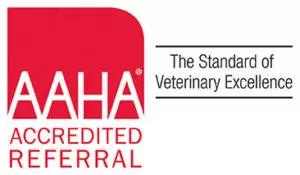Canine Skin Lymphosarcoma
There are two common types of skin lymphoma in dogs: epitheliotropic and non-epitheliotropic.
Epitheliotropic lymphoma is a cancer of immune system cells (lymphocytes). In this case, the cancer is born of lymphocytes residing in the skin (or other superficial sites such as the lips and oral cavity) thus it is generally localized. This disease is similar to mycosis fungoides in people. Most dogs will present with one of the following clinical presentations: a diffuse redness of the skin, plaque-like lesions, scaling, ulcerations or nodules in the skin, oral ulcerations, or involvement at the lip margins. The lesions can be distributed diffusely over the body or be localized to an area of the body. A suspicion of this type of cancer is based upon aspiration but is definitively based on biopsy.
By definition, this is a T cell lymphoma of the skin characterized by the presence of malignant cells surrounding hair follicles and sweat glands on the biopsy and is confined to the epidermis. The epitheliotropic form generally does not spread to other areas of the body until the disease becomes very widespread. Some dogs will present with enlarged lymph nodes at the time of diagnosis. In rare cases, blood involvement can occur (circulating cancerous cells in the blood).
Therapy for this type of cancer in most cases involves chemotherapy. The protocol uses CCNU as the primary agent and Prednisone as the main therapy. CCNU is an oral drug given once every three weeks. Bloodwork is recommended the week after therapy and prior to each cycle. If given many times, this drug can affect the liver thus a liver panel is examined periodically during treatment. Most dogs will respond well to this therapy and remissions are common for several months.
Novel treatments are on the horizon, and immunotherapy in the form of monoclonal antibody treatments is now available for dogs with lymphoma. These may improve the prognosis beyond that achieved with traditional therapy alone.
Since this is not a common form of lymphoma, there is not a great deal of information in the veterinary literature about this type of lymphoma. In a recent study, approximately 88% of dogs will have either a complete response or a partial response (50-100% improvement in skin lesions). The response generally lasts several months in most dogs. In dogs that fail this protocol, full weekly chemotherapy is initiated. In some isolated cases where a single solitary lesion exists, complete surgical removal can be curative. Another option for solitary lesions is radiation therapy. One additional systemic option with treatment is placing dogs on a vitamin A derivative (isotretinoin, or Accutane). This type of therapy may be effective at helping to induce a remission in many cases.
Non-epitheliotropic lymphoma is the least common form of cutaneous lymphoma in the dog. This type of cutaneous lymphoma may be of either B or T cell origin and manifest in the same manner as its epitheliotropic counterpart, although oral involvement is rare and formation of mass lesions is more common. In addition, most dogs will present with systemic involvement as the progression of skin lesions is rapid into the lymph nodes and other organs. Unfortunately, this type of lymphoma is poorly responsive to chemotherapy and remissions may be short. Full weekly chemotherapy is recommended using a combination of chemo drugs. Overall survival times are short, usually 4 months from onset of skin lesions unless a complete remission is reached, which improves the average survival to approximately 1 year.


